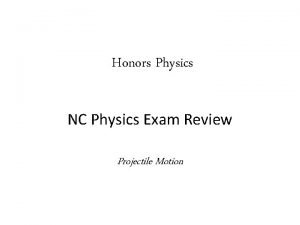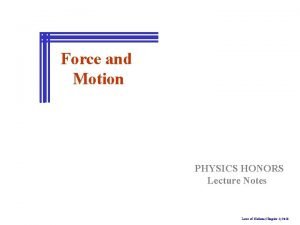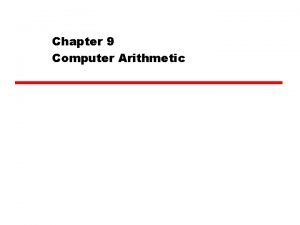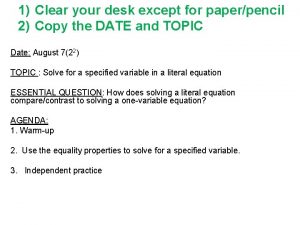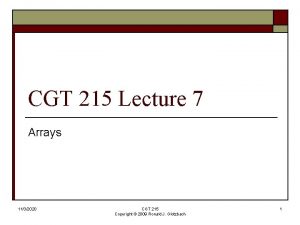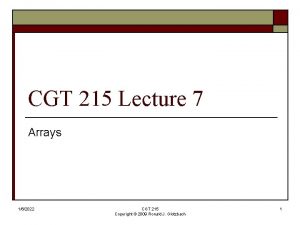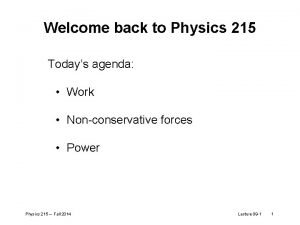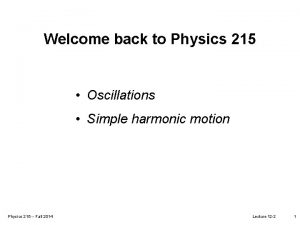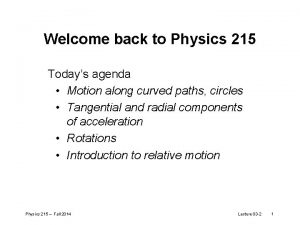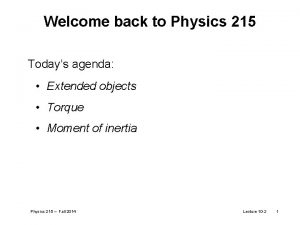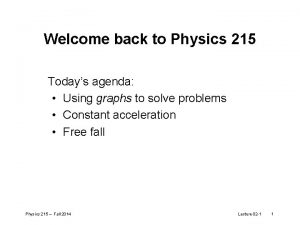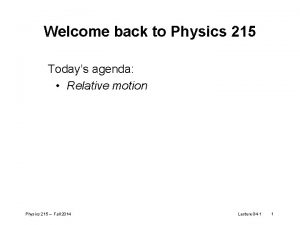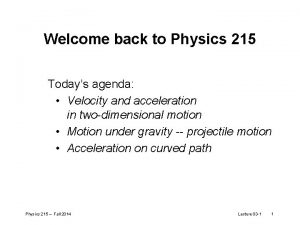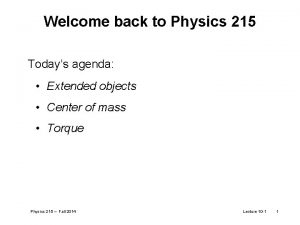Welcome to Physics 215 General Physics I Honors


























- Slides: 26

Welcome to Physics 215! (General Physics I – Honors & Majors) *Please pick up a syllabus* Physics 215 – Fall 2014 Lecture 01 -1 1

SU PHY 215 General Physics I Fall 2014 Course staff: • Lecturer: Prof. Britton Plourde (bplourde@syr. edu) • Workshop instructor: -- Prashant Mishra (prmishra@syr. edu) Physics 215 – Fall 2014 Lecture 01 -1 2

Physics Laboratory Course (PHY 221) • Instructor: Sampere • Lab section taught by teaching assistant • Separate course – Register separately – Independently graded • Lab manuals will be distributed during lab meetings Physics 215 – Fall 2014 Lecture 01 -1 3

Course Information (http: //physics. syr. edu/courses/PHY 215. 14 Fall/index. html) • Books - Physics for Scientists and Engineers, Vol. 1, 3 rd edition, R. D. Knight - Accompanying Student Workbook • Announcements/reminders of exams and homework assignments • Course outline, objectives • Course calendar • Lecture slide shells • Homework/exam solutions, practice exams on Blackboard Physics 215 – Fall 2014 Lecture 01 -1 4

Lectures • Finish reading assignment beforehand! • During lecture, we will. . . – Discuss key concepts – Observe demonstrations – Work through sample problems – Consider conceptual questions • Shells of lecture slides available evening before Physics 215 – Fall 2014 Lecture 01 -1 5

Workshops • Graduate teaching assistant • During workshops you will work in groups • Workbook problems, end-of-chapter problems, other worksheets, practice exams • TA is there to help you but not to lecture • Hands-on learning experience! • Attendance is required Physics 215 – Fall 2014 Lecture 01 -1 6

Physics 215 Fall 2014 Agenda for this week: Tuesday: Intro, position, velocity Wednesday: Motion diagrams (Workbook) Thursday: Kinematics and graphs Friday: Problem Solving Activity on Motion with graphs Physics 215 – Fall 2014 Lecture 01 -1 7

Exams • 3 Exams during semester – Each exam will focus on material from previous ~45 weeks, but may include earlier material as well – 80 -minutes each, during lecture period – Closed book, but can bring one 8. 5” x 11” sheet of handwritten notes (no photocopies) – Practice exam questions in workshop before each exam – Solutions posted online after each exam is graded – Exam 1 -- Sept. 18 • Final exam – Cumulative – 2 hours -- Dec. 11, 12: 45 -2: 45 PM Physics 215 – Fall 2014 Lecture 01 -1 8

Homework • Weekly homework – Typically due in Wednesday workshop, except as noted – Assigned at least one week before due date – Combination of end-of-chapter problems, conceptual questions, exam-style problems (print out from course website) • Reminders of assignments on course website • Solutions to select problems posted online after due date • No late homework will be accepted • HW 1: – Ch. 1 (Knight): 42, 56; Ch. 2 (Knight): 26, 30, 40 – due Wednesday Sept 3 rd in recitation – TA will grade each HW set with a score from 0 to 10 Physics 215 – Fall 2014 Lecture 01 -1 9

Grades • • Exams 1 -3 (drop lowest) Final exam Homework (drop lowest 2) Workshop participation 40% 25% 20% 15% – (can miss 3 meetings w/o penalty) The grades are normalized such that the average course grade is a B- or better, depending on the performance of the class as a whole. Physics 215 – Fall 2014 Lecture 01 -1 10

Objectives for this course: – Develop good understanding of a few important concepts – Reason qualitatively and quantitatively – Learn to apply to unfamiliar situations – Get a flavor of more advanced topics outside of the standard Mechanics curriculum Physics 215 – Fall 2014 Lecture 01 -1 11

Course Outline • Weeks 1 -4: Motion (Kinematics) • Weeks 5 -6: Newton’s Laws (Dynamics) • Weeks 7 -9: Energy, momentum • Weeks 10 -11: Extended objects, rotations • Weeks 12 -13: Gravity, oscillations • Week 14: Thanksgiving break • Week 15: Fluids Physics 215 – Fall 2014 Lecture 01 -1 12

Kinematics-describing motion 1 D Physics 215 – Fall 2014 Lecture 01 -1 13

Position and Displacement • Neglect shape of object and represent by point moving in space (1 D) • Position may be specified by giving distance to origin – x coordinate • Choice of origin arbitrary! – many choices to describe same physical situation. • Hence x-coordinate not unique Physics 215 – Fall 2014 Lecture 01 -1 14

Displacement = change in position x 2 Q x 1 O P origin • Displacement (P Q) = x 2 - x 1 = Dx • Displacement does NOT depend on origin! Physics 215 – Fall 2014 Lecture 01 -1 15

Displacement • Displacement is ‘distance plus direction’ • Displacement Dx is a vector quantity – change in position (vector) of object • In one dimension, this amounts to a sign – Displacement towards increasing x – positive – Displacement towards decreasing x – negative Physics 215 – Fall 2014 Lecture 01 -1 16

Velocity • Definition: Average velocity in some time interval Dt is given by vav = (x 2 - x 1)/(t 2 - t 1) = Dx/Dt • Displacement Dx can be positive or negative – so can velocity – it is a vector, too • Average speed is not a vector, just (distance traveled)/Dt Physics 215 – Fall 2014 Lecture 01 -1 17

Discussion • Average velocity is that quantity which when multiplied by a time interval yields the net displacement • For example, driving from Syracuse Ithaca Physics 215 – Fall 2014 Lecture 01 -1 18

Instantaneous velocity • But there is another type of velocity which is useful – instantaneous velocity • Measures how fast my position (displacement) is changing at some instant of time • Example -- nothing more than the reading on my car’s speedometer and my direction Physics 215 – Fall 2014 Lecture 01 -1 19

Describing motion • Average velocity (for a time interval): vaverage = • Instantaneous velocity (at an instant in time) vinstant = v = • Instantaneous speed |v| Physics 215 – Fall 2014 Lecture 01 -1 20

Instantaneous velocity • Velocity at a single instant of time • Tells how fast the position (vector) is changing at some instant in time • Note while Dx and Dt approach zero, their ratio is finite! • Subject of calculus was invented precisely to describe this limit – derivative of x with respect to t Physics 215 – Fall 2014 Lecture 01 -1 21

Velocity from graph x Vav= Dx/Dt Q P Dx Dt As Dt gets small, Q approaches P and v dx/dt = slope of tangent at P instantaneous velocity t Physics 215 – Fall 2014 Lecture 01 -1 22

Interpretation • Slope of x(t) curve reveals vinst (= v) • Steep slope = large velocity • Upwards slope from left to right = positive velocity • Average velocity = instantaneous velocity only for motions where velocity is constant x t Physics 215 – Fall 2014 Lecture 01 -1 23

When does vav = vinst ? • When x(t) curve is a straight line – Tangent to curve is same at all points in time x t • We say that such a motion is a constant velocity motion – we’ll see that this occurs when no forces act Physics 215 – Fall 2014 Lecture 01 -1 24

Summary of terms • Positions: xinitial, xfinal • Displacements: Dx = xfinal - xinitial • Instants of time: tinitial, tfinal • Time intervals: Dt = tfinal - tinitial • Average velocity: vav = Dx/Dt • Instantaneous velocity: v = dx/dt • Instantaneous speed: |v| = |dx/dt| Physics 215 – Fall 2014 Lecture 01 -1 25

Reading assignment • Kinematics and graphs • Chapter 1 and 2. 1 - 2. 3 in textbook Physics 215 – Fall 2014 Lecture 01 -1 26
 Honors physics semester 2 review
Honors physics semester 2 review Vyi physics
Vyi physics Physics honors notes
Physics honors notes Sentenza corte costituzionale 215/87
Sentenza corte costituzionale 215/87 Completed ics 215 form
Completed ics 215 form Http //servsoc/inicio.aspx
Http //servsoc/inicio.aspx 888-991-9023
888-991-9023 Fixed point addition and subtraction flowchart
Fixed point addition and subtraction flowchart Eecs 427
Eecs 427 Ley 40/215
Ley 40/215 The formula c=5p+215 relates c
The formula c=5p+215 relates c Energy in physics definition
Energy in physics definition Dtu-215
Dtu-215 Tanget ratio
Tanget ratio Economic 215
Economic 215 Guggisberg 10 year development plan
Guggisberg 10 year development plan Stc 215/1994
Stc 215/1994 Iso tc 215
Iso tc 215 Estimation word problems
Estimation word problems Welcome welcome this is our christmas story
Welcome welcome this is our christmas story Creighton honors program
Creighton honors program James scholar honors program
James scholar honors program Deped order no 36 s 2016
Deped order no 36 s 2016 Duels ucsb
Duels ucsb Honors biology ecology test
Honors biology ecology test 04.05 uncle sam's toolbox—honors
04.05 uncle sam's toolbox—honors Honors geometry quadrilaterals test
Honors geometry quadrilaterals test

